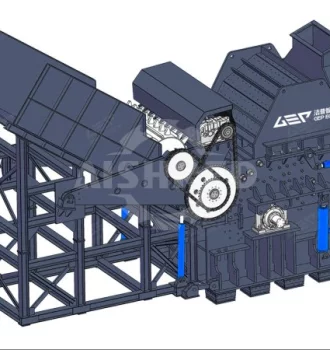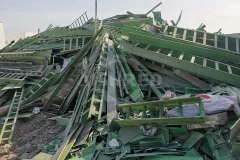
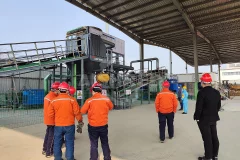
In today's era of focusing on sustainable development, the effective use of resources and recycling has become a crucial issue. And the emergence of disposable recyclable fiber glass shredder undoubtedly provides a powerful means to solve the problem of recycling of fiber glass products.As a material with excellent performance, fiber glass is widely used in various fields. However, with the passage of time and product renewal, a large number of fiber glass products are facing the fate of elimination and abandonment. These discarded fiber glass products, if not properly handled and recycled, will not only cause a waste of resources, but also cause a certain amount of pollution to the environment. The birth of the fiberglass shredder is like a heroic warrior, stepping forward to take up the heavy responsibility of transforming these waste fiberglass products back into usable resources. Through the unique shredding principle and process, it breaks down the waste fiberglass products into fine particles so that
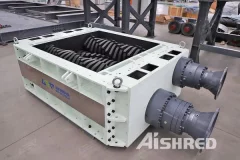
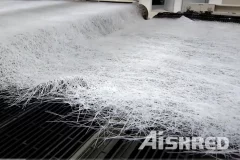
Glass Fiber Four Shaft Shredder
2023-09-13A glass fiber four-shaft shredder is a specialized industrial machine designed to efficiently shred and process glass fiber materials. Glass fiber is a tough and abrasive material, and a four-shaft shredder is well-suited to handle its challenging properties. Here's a brief overview of the key features and considerations when it comes to a glass fiber four-shaft shredder: Working PrincipleA glass fiber four-shaft shredder operates using four rotating shafts, typically arranged in pairs. Each shaft is equipped with multiple blades or cutting elements. These blades rotate at high speeds and intersect with one another to effectively cut and shred the glass fiber material. AdvantagesHigh Cutting Force: Four-shaft shredders are designed for heavy-duty applications and are equipped with a robust drive system and numerous cutting blades. This configuration provides the shredder with high cutting force, making it suitable for shredding tough and abrasive materials like glass fiber.Uniformity and Control: Four-shaft
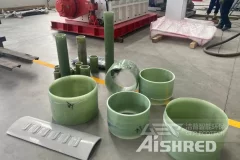
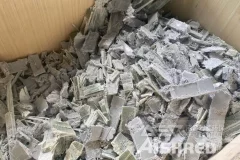
How to Select Waste FRP Pipe Shredder?
2023-02-06FRP(Fiber-glass Reinforced Plastics) is a widely used product in industry now. It can solve the problem of environmental pollution caused by plastic products. At the same time, it has high strength, light weight, corrosion resistance, strong temperature adaptability and low cost. It can be used to manufacture various pipes, containers and other products, and use various waste gas, sewage discharge pipes, de-sulfurization towers, absorption towers and so on. As FRP wastes need to be incinerated, unqualified FRP pipes or containers during production or waste FRP products need to be sent to special incineration plants, cement plants and other industrial waste disposal sites for professional disposal. However, due to the large space occupied by products such as FRP pipes and containers and the high cost of direct transportation, it is necessary to crush and reduce the volume of these products before they are sent to the disposal center. FRP has high hardness and strength. We recommend to use a double shaft
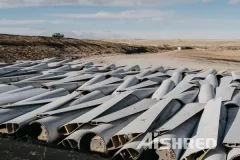
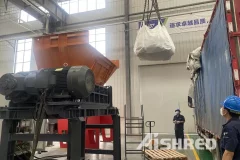
Wind Turbine Blade Shredder for Sale
2022-08-25Wind power is a clean energy source and people love it (although the energy is very unstable, but people have come up with good solutions), but what to do with the scrapped wind turbine blades is a headache. It has been recognized that it is not a good way to send end-of-life wind blades to the landfill, because they take up a lot of space and their main component is fiberglass they are particularly difficult to decompose under natural conditions. Now, we can stop doing that. Using AIShred's industrial waste shredder, wind blades are shredded, which can be used as raw materials for recycled products, or added to cement clinker to increase cement strength. AIShred has different models and specifications of industrial shredders, and can design special blades according to your material characteristics and input and output requirements. We also provide conveying, sorting, packing and other equipment, which can help you build a high-efficiency industrial waste shredding/recycling production line. If you are also
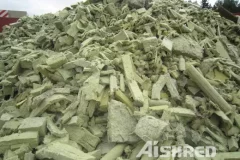
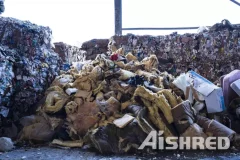
Mineral wool is a general term for a class of industrial products, usually including glass wool, rock wool, slag wool, ceramic fibers, etc. Due to their low density, strong heat resistance, sound absorption, and insulation, they are widely used in thermal insulation, sound insulation, filling, etc. Because of the widespread use of mineral wool, inevitably, a large amount of waste is generated, from two primary sources: manufacturing and post-consumer waste. Whether it is rock wool, glass wool, or slag wool and ceramic fibers, they all have recycling value, they can be used to make new mineral wool products, or as an added component to cement or other products, and can also be used to make other building materials such as recycling bricks. Before recycling mineral wool, there is a key step, shred them into small pieces! You will need one or more industrial shredders for this task. AIShred has a wide range of shredding and sorting equipment for material and energy recovery. Our shredding systems have been used
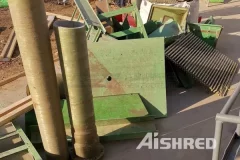

FRP (fiberglass reinforced plastics) products have many advantages, such as high hardness, light weight and corrosion resistance. They are favored by many industrial products and are widely used in chemical industry, engineering, construction, electrical, communication, railway, automobile and other fields. As FRP products gradually reach the life cycle, recycling of waste FRP is becoming a new industry. What equipment is needed to deal with waste FRP? There are generally three directions for the recovery and regeneration of FRP, including chemical pyrolysis, shredding regeneration and energy recovery. First, shredding and regeneration. It is to use the shredder to shred the recycled waste FRP, and sell the FRP fines directly as raw materials, or turn them into FRP, or use them for processing composite materials. Simple and fast operation, typical short, flat and fast business model. Second, energy recovery. This is simpler. You can simply shred the waste FRP, directly package it and sell it to cement plants
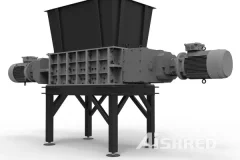
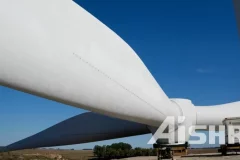
Fiberglass, Fibre-reinforced plastic(FRP) is one of the most commonly used composite materials in the world today, with a wide range of uses, from wind turbine blades to boats and airplanes, to various containers and support components, fiberglass is everywhere. The main task of disposing of fiberglass is to avoid it being landfilled, because it is particularly difficult to degrade. Now, there are two better ways to recycle fiberglass as I know, the first is co-processing in cement kilns, and the second is to process it into recycled products. Co-processing of Fiberglass Waste in Cement KilnThere are many advantages in the treatment of fiberglass waste in cement kilns. One is that the energy in the waste can be recovered and energy consumption is reduced. The other is that fiber materials, silicon, alumina in the fiberglass can not only reduce the consumption of raw materials, but also improve the quality of cement.Material Recycling of Fiberglass Waste for new ProductsNow a new way of recycling fiberglass
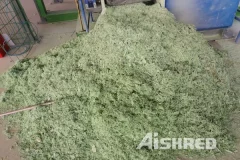
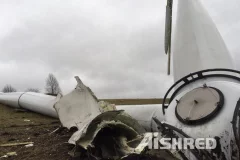
Fiberglass Shredder Machine for Sale
2022-05-16Fiberglass is a composite material based on quartz sand. It is used for the manufacture of building materials, as well as various high-tech and durable lightweight structures. In real life, fiberglass means a glass fiber-reinforced polymer (FRP or GFRP). In modern life, glassfiber is widely used for packaging, covering, structure and other purposes. Accordingly, end-of-life fiberglass components must be disposed of correctly. At present, mechanical shredding are usually used, and the resulting shreded products can be used as fillers in tar, cement or other mixtures, or burned for energy. Fiberglass Shredder MachineGlassfiber is strong and has many kinds, you need a professional equipment to handle it. The low-speed, high-torque, heavy duty dual-shaft shearing shredder can shred glass fibers to a size of about 10cm (the specific size varies with the material), and the single-shaft shredder can shred the material to a smaller size. In early 2022, AIShred delivered a fully automatic Fiberglass two stage
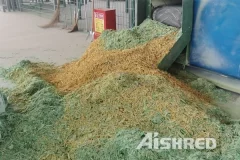
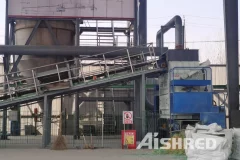
Glass-fibre-reinforced plastic(GFRP or FRP) contains glass as a reinforcing component of the polymer matrix. Glass-fibre-reinforced plastic has a relatively high density and medium weight. It used in many products such as wind turbines. The GFRP does not decompose in landfill sites and cannot be burned either, as the fine fibres clog up incinerator filters.How to Recycling Glass-fibre-reinforced PlasticThe GFRP waste can be reduction to a small size and mixed with paper production residue generated when waste paper is recycled. The mixture is turned into a fine granulate that makes an ideal additive for cement production.Glass-fibre-reinforced Plastic Shredding MachineIn the process of recycling glass fibers, one of the most important processes is to reduce them into small particles, so a huge shredder is required to complete this task. AIShred offers multi-Stage industrial shredder that can process your GFRP, FRP or other materiales.

